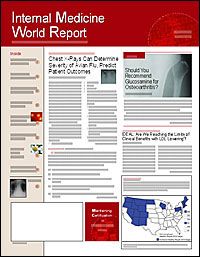Patient Mental Hurdles Impede Osteoporosis Therapy
SAN DIEGO?Up to 50% of women may be nonadherent to bisphosphonate therapy for osteoporosis and some of the reasons may surprise their physicians. Even with once-daily or once-weekly dosing, difficulty in complying with medication instructions and patient beliefs can get in the way of effective therapy, according to data presented at the American College of Rheumatology annual meeting.
To determine the reasons for nonadherence, Paul Thompson, MD, consulting rheumatologist at the Poole Hospital National Health Service Trust, Poole, United Kingdom, and colleagues conducted telephone interviews with 533 postmenopausal women aged >50 years with osteoporosis who had taken bisphos?phonate therapy within the past 12 months. Questions included information on the women's medication-taking behaviors, their beliefs and expectations about osteoporosis, treatment preferences, and osteoporosis risk factors.
A total of 42% of the respondents had sustained a fracture related to osteoporosis, and 63% were currently taking a bisphosphonate, 52% of whom took less than the prescribed amount.
Among the problems affecting adherence were difficulty following medication instructions (46%), too-frequent dosing (44%), and difficulty fitting the dosage into their daily routines (42%).
Beliefs were also a significant obstacle to adhering with therapy. For example, 54% of patients worried that tolerance would develop, and the medications would stop working; 56% feared developing physical dependence; and 44% were worried about long-term medication use. Almost 50% of the women expected that the drugs would prevent fractures. Respondents said that they preferred longer dosing frequencies: monthly over weekly or daily, and especially monthly in combination with a patient support program.
Clinical trial results have demonstrated that bisphosphonates reduce fracture rates by about 50%, but these agents must be taken for a long time to have an effect. "In real life rather than in randomized controlled trials, women do not take bisphosphonates properly, or they tend to stop them after a few months, and this reduces the effectiveness of the treatment," Dr Thompson said. Nonad?herence is partly related to side effects (eg, gastric upset or esophageal burning) or difficulty with the dosing regimen.
Some women stopped treatment because of the perception that side effects would be worse than the risk of untreated osteoporosis. "We concluded that patients' decisions to stop treatment?are based on more than simply the experience of side effects," he added.
"Women were more likely to take their medications correctly if they had a previous osteoporotic fracture," Dr Thompson explained. "They were also more likely to take their medications correctly if they had concerns about the medication." While counterintuitive, Dr Thompson said this finding may reflect a specific kind of patient who is fastidious about both her disease and its treatment. The presence of even unrelated symptoms, such as back pain, increased medication use.
"Continued treatment was associated with weekly rather than daily dosing," Dr Thompson said. He recommended better patient education about the disease, medications and their effects, and follow-up. ?D.M.K.
